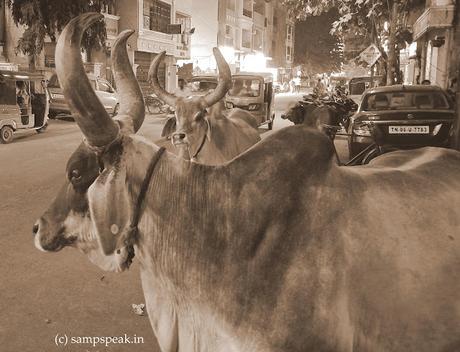இந்த கொம்புகளை பார்க்க பயமாக உள்ளதா ! - அவை சாது என்பர் சிலர் ! பார்த்தாலே பயம் கொள்வர் பலர். கொம்புகள் ஏன் ??

தமிழிலக்கிய வரிசையில் "நீதிவெண்பா" எனும் நூலும் ஒன்று. சம்ஸ்கிருத மொழியிலுள்ள நீதி சாஸ்திரங்களை வெண்பாக்களாகப் கொண்ட இந்நூலில் 100 பாடல்கள் இருக்கின்றன. இதில் நாம் அறிந்த ஒரு பாடல் : பாடலின் பொருள் நன்கு புலப்படுமாறு அமைவது தெளிவு எனப்படும். செய்யுளில் திரிபுச் சொற்கள், கடினமான புணர்ச்சி விதிகள், குறிப்புப்பொருள்கள் ஆகியன அமையாமல், இயற்சொற்களாலும் எளிமையான சொற்புணர்ச்சிகளாலும் அமைவது ‘தெளிவு’ என்னும் குணத்தில் அடங்கும்.
கொம்புளதற்கு ஐந்து குதிரைக்கு பத்துமுழம்
வெம்புகரிக்கு ஆயிரம்தான் வேண்டுமே - வம்புசெறி
தீங்கினர்தம் கண்ணில் தெரியாத தூரத்து
நீங்குவதே நல்ல நெறி.
கொம்பு உள்ள கால்நடைகளான மாடு, போன்றவற்றிடமிருந்து காத்துக் கொள்ள ஐந்து முழம் தள்ளி இருத்தல் வேண்டும். குதிரையிடமிருந்து பத்து முழமும், மதங்கொள்ளக்கூடிய யானையிடமிருந்து ஆயிரம் முழமம் ஒதுங்கி இருத்தலே நலம். உருவிலும், உள்ளத்தாலும் வஞ்சனையும் சூதும் மேலோங்கி நிற்கும் மானுடவர்க்கத்திடமிருந்து கண்காணாத தூரம் போய்விடுவதே நன்று.
The verse from Tamil literary work states how much of distance one should maintain from animals – starting from 5 cubit (forearm length) for horned animals, to 10 for horse and thousands for angry elephant – it states that one should move away from the sight of vengeful people.
In one sense, who is cruel and who should move out of whose sight ! – is it man from the animal or is it not humans most dangerous, killing and exterminating all animals, changing their genes to suit his needs !!
A horn is a permanent pointed projection on the head of various animals that consists of a covering of keratin and other proteins surrounding a core of live bone. Horns are distinct from antlers !! Cattle horns arise from subcutaneous connective tissue (under the scalp) and later fuse to the underlying frontal bone. The keratin in the epidermis, when cornified and thickened, is referred to as horn. The dermis of horn gives the structures their 3-D structure and shape. Cattle, some sheep, goats and antelope posess horns and these are permanent organs. Breeds without horns are termed polled breeds.
Horns have a central, conical bony core or cornual process that grows out from the frontal bone of the skull. After 6 months of age, the bone becomes hollow and the space within it is continuous with the frontal sinuses. The surface of the bone is ridged and porous and is covered with papillated dermis that is continuous with the periosteum and epidermis which keratinises and forms the protective covering of the horn.
Horns are needed by the animal for thermo-regulation and cooling. They are also a contributing factor in the animals natural biology and immunity. Horned livestock are better able to defend themselves and their young from predators.
However, man has different views – in dairy and beef production, there is a pressure towards breeding for hornless - or polled - cattle not because of any concern for the welfare of horned animals, but hornless meat provider suits the beastly man more.Producers routinely disbud horned calves to stop horns from growing .. .. ..
Here are two beau cows roaming in the night time on the streets of Triplicane.
With regards – S. Sampathkumar
4.3.2023

